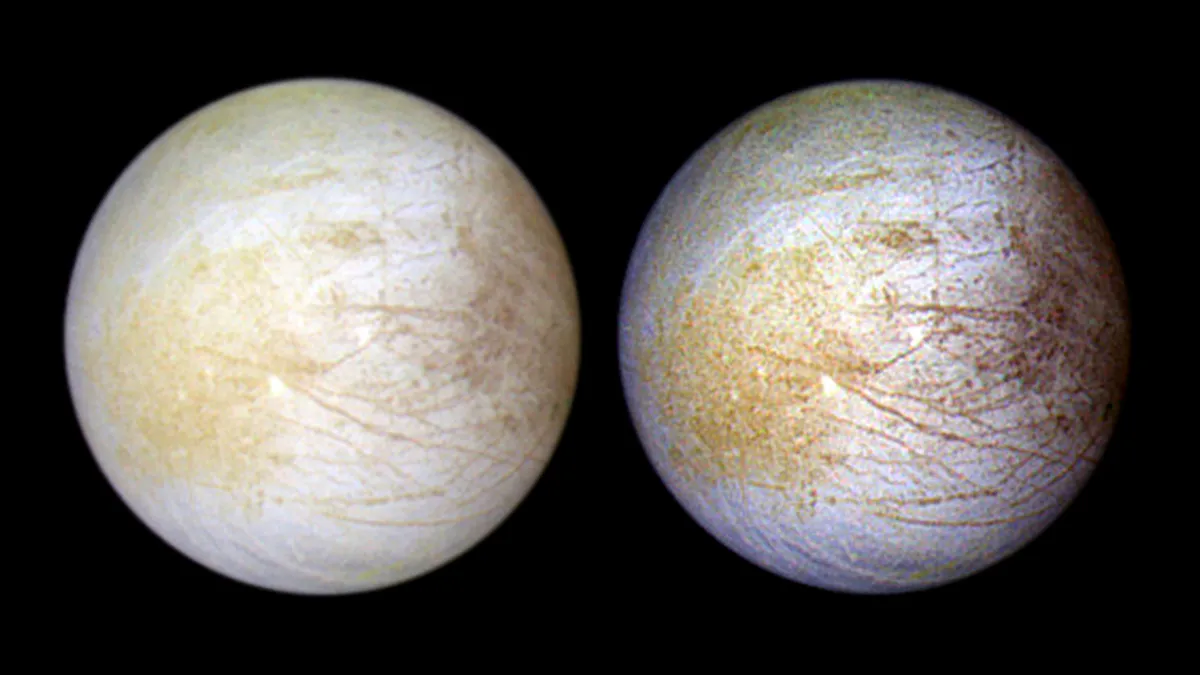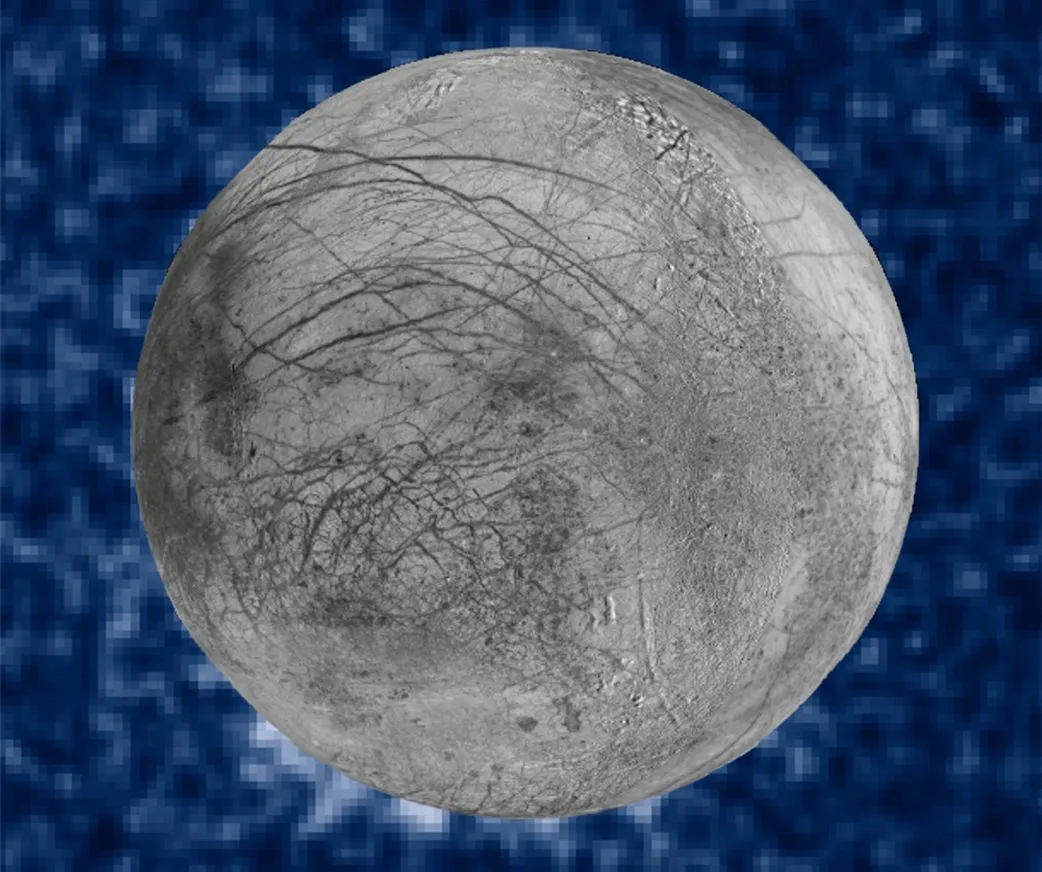Half a billion miles (800 million kilometres) from Earth, radiation-drenched and dimly lit by the feeble glow of the distant Sun, lies a shimmering waterworld.
This is the destination NASA’s Europa Clipper set off to explore in October 2024.
Its decade-long voyage may reveal that a happy coincidence of conditions needed for life – water, organics and energy – somehow fell into place on a world beyond our own.
Get news and updates about the Europa Clipper launch
Read more


Why Europa?
Circling giant Jupiter at a distance of 671,000km (417,000 miles), Europa is an enigmatic moon, smaller in diameter than Australia is wide.
Its surface rhythmically flexes under its parent planet’s colossal gravity and is washed by the intense Jovian magnetic field, 20,000 times fiercer than Earth’s.
Nine tenths as big as the Moon yet five times further from the Sun, Europa’s daytime highs never climb above –160°C (–260°F).
Its Texas-sized nickel-iron core and rocky mantle are overlaid by an icy crust, maybe 15–25km (10–15 miles) thick and rendered rock-solid under such frigid extremes.
But hard as it may seem in this radiation-blasted wasteland, life of sorts might once (and could still) have thrived at Europa: truly an unlikely Eden.
Visually, Europa bears few hallmarks of the only known harbour of life: our iridescent blue-and-white planet, Earth.
Past missions to Europa
In 1979, NASA’s Voyager 1 and 2 probes revealed what Europa Clipper deputy project scientist Bonnie Buratti of NASA’s Jet Propulsion Laboratory (JPL) likens to “a cracked egg”: its 0.64 albedo (how much light its surface reflects) brighter than Arctic sea-ice; and its curious reddish tincture likely caused
by harsh Jovian radiation.
The Voyagers photographed linear ridges and furrows crossing the surface, with peculiar blotches dotted across the glassy landscape.

"Scientists date surfaces by counting craters," says Buratti. And Europa’s lack of craters implies a young surface, perhaps 20 million years old and still undergoing active internal change.
Tantalisingly, the Voyagers detected fractures in that terrain, facilitating movement of dark subsurface material into the resulting gaps – and inviting speculation that a layer of water or warm ice might lurk beneath the Europan crust.
In 1996–2000, NASA’s Galileo probe found strong evidence for a salty ocean holding 3 billion cubic kilometres (720 million cubic miles) of water, twice as much as our oceans.

That ocean could be 80–100km (50–60 miles) deep – that’s nine times deeper than the Mariana Trench, the deepest point in any ocean on Earth.
The Galileo probe also showed that an upwelling of warm, slushy ice was indeed at work.
It detected an intrinsic magnetic field and measured directional changes consistent with the presence of a subsurface ‘shell’ of electrically conducting material, like a salty liquid ocean.

Credits: NASA/ESA/W. Sparks (STScI)/USGS Astrogeology Science Center
Elsewhere, the Hubble Space Telescope discovered Europa’s thin oxygen atmosphere and in 2013–2017 saw water vapour emissions rising 100km (60 miles) high.
That furnished persuasive evidence of material ejected directly from the ocean.
In 2019, Hubble found sodium chloride (table salt), suggesting the ocean could be saltier and more Earth-like than originally thought… and more amenable to microbial life.

Life on Europa?
"Every scenario for life on Earth has liquid water," Buratti explains.
"The search for life is top of the list: are we alone? But our understanding of how life originated and how it thrived has really evolved over the time that I’ve been in this field."
On Earth, life sprouted in the unlikeliest of places, notably hydrothermal vents in deep ocean trenches with no sunlight.
"Life formed in these thermal vents because the bacteria there are very primitive," Buratti continues.
"They’re at the base of the tree of life, so our understanding of where to look for life has changed."
But Buratti remains cautiously guarded about finding life.
"It looks like the conditions for life are there," she says. "We’re empiricists and we don’t have any evidence yet. Our mission’s going to find evidence and work from there."

How the Europa Clipper mission came about
A dedicated Europa mission has long held high-priority status.
Top-level goals include measuring the thickness of the crust, deciphering Europa’s complex geology and ascertaining the nature, size, saltiness and composition of the ocean.
In 1997, NASA proposed a radar-and-altimeter-equipped Europa Orbiter, but costs, power needs and a lengthy mission duration precipitated its 2002 cancellation.
A Jupiter Icy Moons Orbiter (JIMO) with ion or nuclear electric propulsion was scratched in 2005 as too ambitious.
Next came the US/European Europa Jupiter System Mission (EJSM), including NASA’s Jupiter Europa Orbiter.
It too was axed in 2011. But a kernel of EJSM survived.

Europe’s share of that mission became the Jupiter Icy Moons Explorer (JUICE), launched in 2023.
And a US mission recommended by the National Research Council in 2013 led to the selection of nine science instruments in 2015 and approval of a voyage which in 2017 became known as Europa Clipper.
Europa Clipper's name comes from 19th-century ‘clippers’: three-masted sailing ships that plied the world’s oceans, delivering tea and other commodities.
But for NASA it has another meaning: Europa Clipper will not circle Europa.
Instead, it will orbit Jupiter, tweaking its trajectory to accomplish 44 fly-bys of the moon at distances from 26km (16 miles) to 2,700km (1,678 miles).

Europa Clipper orbit and science objectives
Europa’s location deep inside Jupiter’s radiation field would ordinarily fry Europa Clipper’s electronics within months.
So to facilitate and survive a multi-year mission, it will ‘clip’ past the moon every few weeks – "rinse and repeat, many times," says project scientist Robert Pappalardo of JPL – to spend as little time as needed in the high-radiation flux before heading outbound to safer distances to transmit data to Earth.
And that data will be collected with a comprehensive toolkit:
- High-resolution thermal infrared imager
- Infrared spectrometer
- Imaging system with wide- and narrow-angle cameras
- Ultraviolet spectrograph,
- Magnetometer on an 8.5-metre (25ft) boom
- Plasma detector
- Mass spectrometer
- Dust sampler
They will allow Clipper to image Europa’s surface at resolutions of 50cm (20 inches) per pixel, directly sample water vapour plumes during low-altitude fly-bys, determine crust thickness and ocean
salinity, map organics – amino acids, tholins, salts and acid hydrates – and make inferences about potential habitability.

And a 16-metre (52ft) ice-penetrating radar will ‘sound’ Europa’s crust while an altimeter measures tides and surface roughness.
All told, it will map 95% of Europa at resolutions of 100 metres (330 feet): a sixfold increase in coverage at five times better quality than earlier missions.
Those nine instruments sit within Europa Clipper, the biggest spacecraft NASA has ever sent to a planet.
At 6.6 metres (20ft) tall and weighing 6,000kg (13,370lb), the SUV-sized Europa Clipper includes a 3-metre (10ft) high-gain antenna for communications and gravity measurements, and 24 thrusters for manoeuvres and the lengthy, six-hour-plus Jupiter orbit insertion engine burn.
And as clipper ships of old had large-area sails, so Europa Clipper’s pair of five-piece solar arrays are the biggest ever used at Jupiter.
Each extends to 14.2 metres (46.5ft) and the spacecraft spans an entire basketball court when fully deployed.
Though sunlight at the distance of Jupiter is only 4% as intense as it is near Earth, the arrays will generate 600 Watts of electrical power.
Messages from Earth
Shielding Europa Clipper’s electronics from Jovian radiation is a 150kg (330lb) titanium-aluminium vault with 7.6cm-thick (3-inch) walls.
A plate on the vault door bears a poem, In Praise of Mystery: A Poem for Europa, penned by US Poet Laureate Ada Limón, plus the names of 2.6 million people etched onto a microchip via the ‘Send Your Name to Europa’ online campaign.
The plate’s reverse face carries another unique message: artwork featuring the word water, spoken in 103 languages and converted into visual depictions of soundwaves, called waveforms.
These waveforms emanate from a pictogram that represents the American Sign Language symbol for water.
Also in pride of place on the vault plate is the Drake equation, honouring astronomer Frank Drake’s mathematical formulation to assess the likelihood of finding advanced extraterrestrial civilisations, along with representations of the spectral lines of atomic hydrogen and the hydroxyl radical – colloquially termed the ‘water hole’ – and a portrait of planetary scientist Ronald Greeley, a driving force behind the mission.

Europa Clipper launch and flightpath
NASA's Europa Clipper launched from Kennedy Space Center at 12:06 EDT (16:06 UTC) on Monday 14 October 2024.
Early plans to use a NASA Space Launch System (SLS) were abandoned due to high costs, lack of availability for the launch window and vibrations associated with its solid-fuelled boosters.
The spacecraft will gain two gravity-assisted boosts, passing Mars at a distance of 500–1,000km (300–600 miles) in February 2025, then Earth at 3,200km (2,000 miles) in December 2026.

After voyaging across 2.9 billion kilometres (1.8 billion miles), it will reach Jupiter in April 2030, setting the scene for 44 Europa fly-bys in 2031–2034.
Those fly-bys will weigh distances, speeds, fuel and lighting conditions to maximise science return and spacecraft safety.
After each fly-by, the spacecraft will transmit data to Earth for seven to 10 days before heading into its next deep dive towards Europa.
And to ensure the spacecraft does not contaminate Europa, at the end of its mission in 2034 it will deliberately be crashed into Jupiter’s moon Ganymede.
But as Europa Clipper’s life ends, it might find that Europa – like Goldilocks in her hapless quest for the ideal porridge – has a set of conditions that are ‘just right’ for life to begin.
And the implications for human society of such a discovery could be profound.
Are you excited about the Europa Clipper mission? Is it our best chance of finding life beyond Earth? Let us know by emailing contactus@skyatnightmagazine.com.
This article appeared in the October 2024 issue of BBC Sky at Night Magazine
